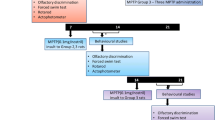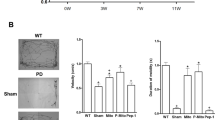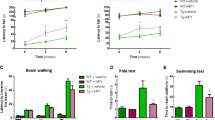Abstract
Parkinson’s disease (PD) is a neurodegenerative disease with a hallmark motor defect caused by the death of dopaminergic neurons in the substantia nigra. Intranasal drug administration may be useful for Parkinson’s treatment because this route avoids first-pass metabolism and increases bioavailability in the brain. In this study, we investigated the neuroprotection/neurorestoration effect of dopamine D3 receptor (D3R) agonists administered via both intranasal and subcutaneous routes in the MPTP (1-methyl-4-phenyl-1,2,3,6-tetrahydropyridine)-induced PD mouse model. Furthermore, we employed D3R knock-out mice to validate the dependence on D3R signaling. We found that in wild-type mice, but not D3 receptor knockout mice, both intranasal and subcutaneous administration of D3R agonists rescue dopamine (DA) depletion in the striatum as well as DA neuronal death in the substantia nigra after MPTP treatment. Moreover, subcutaneous 7-OH-DPAT administration significantly improved gait performance (stride length and overall running speed) of MPTP-lesioned mice after 7 and 14 days of recovery. In addition, the distribution of D3 agonist 7-OH-DPAT was measured in designated brain areas by mass spectrometry analysis after subcutaneous and intranasal administration. Our data suggest that intranasal administration of D3R agonist would be a practical approach to treat PD.




Similar content being viewed by others
Abbreviations
- PD:
-
Parkinson’s disease
- DA:
-
Dopamine
- D3R:
-
Dopamine D3 receptor
References
Amende I, Kale A, McCue S, Glazier S, Morgan JP, Hampton TG (2005) Gait dynamics in mouse models of Parkinson’s disease and Huntington’s disease. J Neuroeng Rehabil 2:20
Anderson DW, Neavin T, Smith JA, Schneider JS (2001) Neuroprotective effects of pramipexole in young and aged MPTP-treated mice. Brain Res 905:44–53
Antonini A, Tolosa E, Mizuno Y, Yamamoto M, Poewe WH (2009) A reassessment of risks and benefits of dopamine agonists in Parkinson’s disease. Lancet Neurol 8:37–929
Beare JE, Morehouse JR, DeVries WH, Enzmann GU, Burke DA, Magnuson DS, Whittemore SR (2009) Gait analysis in normal and spinal contused mice using the TreadScan system. J Neurotrauma 26:56–2045
Bennett JP Jr, Piercey MF (1999) Pramipexole–a new dopamine agonist for the treatment of Parkinson’s disease. J Neurol Sci 163:25–31
Bhatt J, Subbaiah G, Singh S (2006) Liquid chromatography/tandem mass spectrometry method for simultaneous determination of risperidone and its active metabolite 9-hydroxyrisperidone in human plasma. Rapid Comm Mass Spectr 20:2109–2114
Blagg J, Allerton CMN, Batchelor DVJ, Baxter AD, Burring DJ, Carr CL, Cook AS, Nichols CL, Phipps J, Sanderson VG, Verrier H, Wong S (2007) Design and synthesis of a functionally selective D3 agonist and its in vivo delivery via the intranasal route. Bioorg Med Chem Lett 17:6691–6696
Bode M (2009) Dopamine agonist therapy in early Parkinson’s disease. A survey of a Cochrane review. Ugeskr Laeger 171:9–2996
Budsberg SC, Verstraete MC, Soutas-Little RW (1987) Force plate analysis of the walking gait in healthy dogs. Am J Vet Res 48:8–915
Carter RJ, Lione LA, Humby T, Mangiarini L, Mahal A, Bates GP, Dunnett SB, Morton AJ (1999) Characterization of progressive motor deficits in mice transgenic for the human Huntington’s disease mutation. J Neurosci 19:57–3248
Chen S, Zhang X, Yang D, Du Y, Li L, Li X, Ming M, Le W (2008) D2/D3 receptor agonist ropinirole protects dopaminergic cell line against rotenone-induced apoptosis through inhibition of caspase- and JNK-dependent pathways. FEBS Lett 582:10–603
Clarke CE, Guttman M (2002) Dopamine agonist monotherapy in Parkinson’s disease. Lancet 360:9–1767
Cohen AH, Gans C (1975) Muscle activity in rat locomotion: movement analysis and electromyography of the flexors and extensors of the elbow. J Morphol 146:96–177
Danielyan L, Schafer R, von Ameln-Mayerhofer A, Buadze M, Geisler J, Klopfer T, Burkhardt U, Proksch B, Verleysdonk S, Ayturan M, Buniatian GH, Gleiter CH, Frey WH (2009) Intranasal delivery of cells in the brain. Eur J Cell Biol 88:315–324
Du F, Li R, Huang Y, Li X, Le W (2005) Dopamine D3 receptor-preferring agonists induce neurotrophic effects on mesencephalic dopamine neurons. Eur J Neurosci 22:2422–2430
Fernagut PO, Diguet E, Labattu B, Tison F (2002) A simple method to measure stride length as an index of nigrostriatal dysfunction in mice. J Neurosci Methods 113:123–130
Hanson LR, Frey WH (2008) Intranasal delivery bypasses the blood-brain barrier to target therapeutic agents to the central nervous system and treat neurodegenerative disease. BMC Neurosci 9:S3–S5
Hausdorff JM (2009) Gait dynamics in Parkinson’s disease: common and distinct behavior among stride length, gait variability, and fractal-like scaling. Chaos 19:026113
Iida M, Miyazaki I, Tanaka K, Kabuto H, Iwata-Ichikawa E, Ogawa N (1999) Dopamine D2 receptor-mediated antioxidant and neuroprotective effects of ropinirole, a dopamine agonist. Brain Res 838:51–59
Illum L (2004) Is nose-to-brain transport of drugs in man a reality? J Pharm Pharmacol 56:3–17
Inden M, Kitamura Y, Tamaki A, Yanagida T, Shibaike T, Yamamoto A, Takata K, Yasui H, Taira T, Ariga H, Taniguchi T (2009) Neuroprotective effect of the antiparkinsonian drug pramipexole against nigrostriatal dopaminergic degeneration in rotenone-treated mice. Neurochem Int 55:760–767
Iravani MM, Haddon CO, Cooper JM, Jenner P, Schapira AH (2006) Pramipexole protects against MPTP toxicity in non-human primates. J Neurochem 96:1315–1321
Jankovic J (2008) Parkinson’s disease: clinical features and diagnosis. J Neurol Neurosurg Psychiatry 79:368–376
Joyce JN, Millan MJ (2007) Dopamine D3 receptor agonists for protection and repair in Parkinson’s disease. Curr Opin Pharmacol 7:100–105
Kalinderi K, Fidani L, Katsarou Z, Bostantjopoulou S (2011) Pharmacological treatment and the prospect of pharmacogenetics in Parkinson’s disease. Int J Clin Pract 65:1289–1294
Lao CL, Lu CS, Chen JC (2013) Dopamine D(3) receptor activation promotes neural stem/progenitor cell proliferation through AKT and ERK1/2 pathways and expands type-B and -C cells in adult subventricular zone. Glia 61:475–489
Mathison S, Nagilla R, Kompella UB (1998) Nasal route for direct delivery of solutes to the central nervous system: fact or fiction? J Drug Target 5:415–441
Matsukawa N, Maki M, Yasuhara T, Hara K, Yu G, Xu L, Kim KM, Morgan JC, Sethi KD, Borlongan CV (2007) Overexpression of D2/D3 receptors increases efficacy of ropinirole in chronically 6-OHDA-lesioned Parkinsonian rats. Brain Res 1160:113–123
Olanow CW, Jenner P, Brooks D (1998) Dopamine agonists and neuroprotection in Parkinson’s disease. Ann Neurol 44:S167–S174
Piercey MF (1998) Pharmacology of pramipexole, a dopamine D3-preferring agonist useful in treating Parkinson’s disease. Clin Neuropharmacol 21:141–151
Pires A, Fortuna A, Alves G, Falcao A (2009) Intranasal drug delivery: how, why and what for? J Pharm Pharm Sci 12:288–311
Prediger RD, Aguiar AS Jr, Rojas-Mayorquin AE, Figueiredo CP, Matheus FC, Ginestet L, Chevarin C, Bel ED, Mongeau R, Hamon M, Lanfumey L, Raisman-Vozari R (2010) Single intranasal administration of 1-methyl-4-phenyl-1,2,3,6-tetrahydropyridine in C57BL/6 mice models early preclinical phase of Parkinson’s disease. Neurotox Res 17:114–129
Reger MA, Watson GS, Green PS, Wilkinson CW, Baker LD, Cholerton B, Fishel MA, Plymate SR, Breitner JC, DeGroodt W, Mehta P, Craft S (2008) Intranasal insulin improves cognition and modulates beta-amyloid in early AD. Neurology 70:440–448
Stevens J, Ploeger BA, van der Graaf PH, Danhof M, de Lange EC (2011) Systemic and direct nose-to-brain transport pharmacokinetic model for remoxipride after intravenous and intranasal administration. Drug Metab Dispos 39:2275–2282
Thanvi B, Lo N, Robinson T (2007) Levodopa-induced dyskinesia in Parkinson’s disease: clinical features, pathogenesis, prevention and treatment. Postgrad Med J 83:384–388
Van Kampen JM, Eckman CB (2006) Dopamine D3 receptor agonist delivery to a model of Parkinson’s disease restores the nigrostriatal pathway and improves locomotor behavior. J Neurosci 26:7272–7280
Van Kampen JM, Hagg T, Robertson HA (2004) Induction of neurogenesis in the adult rat subventricular zone and neostriatum following dopamine D3 receptor stimulation. Eur J Neurosci 19:2377–2387
Zou L, Jankovic J, Rowe DB, Xie W, Appel SH, Le W (1999) Neuroprotection by pramipexole against dopamine- and levodopa-induced cytotoxicity. Life Sci 64:1275–1285
Author information
Authors and Affiliations
Corresponding author
Rights and permissions
About this article
Cite this article
Lao, C.L., Kuo, YH., Hsieh, YT. et al. Intranasal and Subcutaneous Administration of Dopamine D3 Receptor Agonists Functionally Restores Nigrostriatal Dopamine in MPTP-Treated Mice. Neurotox Res 24, 523–531 (2013). https://doi.org/10.1007/s12640-013-9408-1
Received:
Revised:
Accepted:
Published:
Issue Date:
DOI: https://doi.org/10.1007/s12640-013-9408-1




